
|   |

|   |
 e-mail: ukb7@rediffmail.com The Yuletide Cadenza Photos courtesy: Asim Dattagupta January 6, 2018 Kolkata's Christmas spirit - extended easily up to the New Year night revelry - has long lost its sheen of being a mere religious affair. All the Masses conducted in the worthwhile churches - including the most colourful one in St. Paul's Cathedral - spread only the noble message: "Goodwill to all and malice towards none." The nostalgia for having been a British capital - lost more than a century ago - is still palpable in the strong Anglo-Indian quarters of Boe Barracks and the royalty-tinged trinkets on sale at the Hogg Market. But the surging crowds could not give a damn and overflow into the most happening streets where any vehicular traffic is out of the question for quite a while, and the goodies like Flurry's cakes and Trinka's savouries continue to be mouth-salivating and delicious. The only sad shadow that is looming large this year hangs from the Metro Cinema arcade - - the undisputed trysting spot for decades of lovers - which is now yielding to the hammers of the other Metro: the under-and over-ground Rail arteries of the burgeoning city. Parva Bharatiyam, the festival of music and dance presented from December 23 to January 1 by the Eastern Zonal Cultural Centre in the metropolis, celebrated the Season of Peace and Amity with a sumptuous feast for the dilettanti, cutting out, for this critic, the grand musical repast: from the classical vocals by redoubtable Ustad Rashid Khan on the first day, to the delectable modern songs by Jojo on the last day, the accent on classical genres of dance - - usually not savoured together - on other days could not be missed. The curtain-raiser was the "semi-classical and folk dance" by Barnali Dance Troupe from Assam, who opened with Shiv Vandana, based on Shankaracharya's Shivashtakam, danced as a solo Kathak that could hardly pass muster. After yet another lackadaisical group dance to the full song of Vande Mataram in Mishra Des raga came their best group effort, Bhor Taal, literally a morning cadence that usually forms the core of the classical Sattriya dance, with captivating lateral sways and undulations of the torso. Next were compositions by three icons of Assam - - a devotional song by Jyotiprasad Aggarwal, a seasonal song by Dr. Bhupen Hazarika and a patriotic song by Lakshmikanta Bezbarua - - all accompanied by solo and group dances, punctuated liberally by the Bihu rhythms. One, indeed wondered what prevented the choreographer, Barnali Mohanta, from showcasing full-blooded Rangali Bihu or Bhogali Bihu or Kangali Bihu, which could pulsate with the state's heartbeats so very vividly for the viewers. 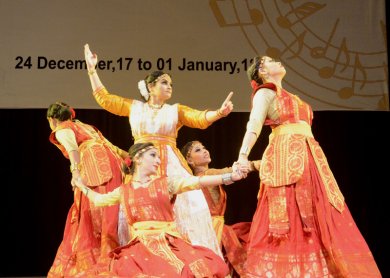 Barnali Dance Troupe 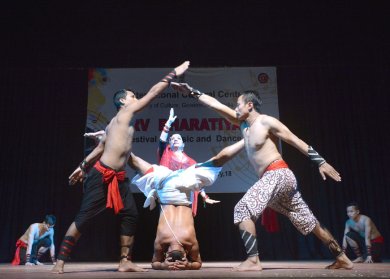 Priti Patel and troupe Manipuri dance by Anjika followed next. This was the handiwork of the seasoned dancer Priti Patel who has been holding fort since the Jhaveri Sisters' time in Kolkata and Mumbai, for over three decades. Called Ananta, the program aimed at depicting Manipur's wholesome culture and pay homage to the all-pervading Creator, omnipresent and omniscient. Lai Haraoba, the ancient rituals of the land, was beautifully recreated with its static mandalas and chromatic chakras, and with the four male partners weaving many horizontal and vertical patterns. The male priest's solo that followed was quite captivating. Thereafter, with only a glimpse of Sankirtana and the collective chant of Naam Gaan, the stage was set for a resplendent Raas Lila where the traditionally attired Radha-Krishna duo launched their vigorous pas de deux captivating the spectators. A Pung Cholam was also thrown in, for good measure. The concluding segment was a breathtaking depiction of Thang Ta complete with swirling bamboo sticks first, then with swashbuckling swords. The overall idea of presenting the basics of Manipur's performing arts and their richness that would find a niche anywhere came through fairly well. Odissi dance compositions presented by the noted dancer Sharmila Biswas with her well-trained group of dancers, one male and a bevy of females, were an eye-catching affair. They began with Ranga Puja based on an assortment of traditional hymns that the rural priests in Odisha chanted while invoking the blessings of the divinities before starting a performance. The sonorous voices, offering an ode to Ganesha, followed where the dancers rose from their supine positions on the floor and executed their worshipful stances. Then followed three very well-choreographed pieces: Gati Vilas, Katha Surpanakha and Moksha Mangalam. In the first, dancers ably imitated the motions and movement of the animals: the speed of the stallions, the grace of the swimming swans, the swift darting of the gazelles and the precise strikes of the hawks. In the second, Sharmila first assumed the role of a narrator - very refreshing in Odissi repertoire - and described the travails of the young demon-princess, less sinning than sinned against. Then she took the dance floor and unveiled Surpanakha's lifelong predicaments by etching them in well crafted slow motion choreography. Moksha Mangalam was the finale, patterned in most unusual groupings of twos and threes, brushing past each other, swiftly appearing from and disappearing into the wings, and forming clusters and dissolving them in a trice. It was like no other Moksha ever seen before. 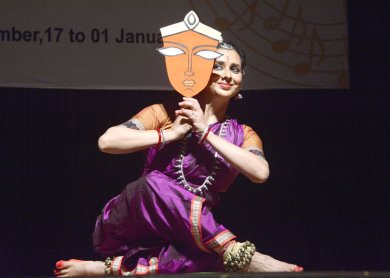 Sharmila Biswas 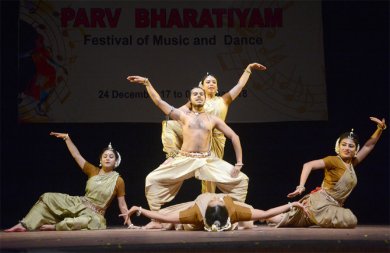 Sharmila Biswas and troupe 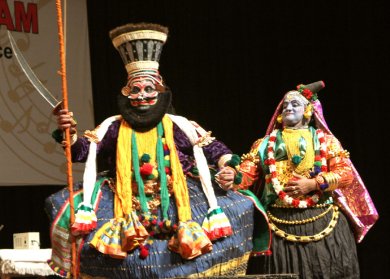 Kalamandalam Venkitt and troupe 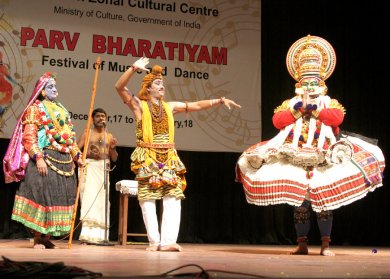 Kalamandalam Venkitt and troupe Kathakali dance presented by Kalamandalam Venkitt, was quite a welcome entry in the city's classical dance scene. In the limited duration of one hour allotted to each form, Venkitt did well to choose a short dance-drama Kiratam from the Mahabharata and, what is more, he garnered the cooperation of two other stalwarts - Kalamandalam Vassunni, professor at Vishva-Bharati University and Kalamandalam Amaljit, from the capital's International Centre for Kathakali. The well-known story of a penancing Arjuna seeking the Paashupat weapon from Shiva; the latter's testing his disciple's sincerity through a mock battle and trouncing him; and lastly reviving him, revealing himself and rewarding him with the desired weapon, was quite well etched. Surprisingly, while Vassunni's Kirata - - with many pure nritta segments - - was easily the best of the lot and was ably supported by Amaljit's stoic Arjuna, Venkitt's own Kiratini - Parvati in disguise - was seemingly the weak link, with her postures somewhat lokadharmi. Even her glances perpetually fixed at Kirata's face was in direct contravention to the Kathakali tenets, namely, its dramatis personae - being transported from "there and then" to "here and now" - - never look directly at each other's countenance. Kathak dance, presented by Dr. Malavika Mitra, was the penultimate classical form. Trained in both Jaipur and Lucknow Gharana, she has been a luminary in the Kolkata scene for the last half a century, having launched her career in Tansen Sangeet Sammelan in 1957. Malavika's opening foray was Ganga Stuti, depicting the descent of the holy river from the heavens, her landing into Shiva's matted hair locks, her fertilizing the verdure plains, and her current status of neglect and stultification. She then reverted to technical Kathak with bandish in vilambit teentaal. Her rapid fire cascade of Thaat, Uthaan and Gati then transited into the fountain-like gurgling of Parmelus and the sparkle of Anaagat in the Badal-Bijli Karvaan. Next, introducing her guru Omprakash Maharaj's Kali Parhant, Malavika elaborated his most stylised Gat Nikas and several of his Nazar ki Adaayen, all tinged with delicate aesthetic nuances. Concluding her solo presentation with a summary recital on Dashavatara, she described - - with a characteristic ardour - - this planet's own episode of evolution (mirrored in Vishnu's ten incarnations): marine beings (the Fish); amphibians (the Tortoise); the landed animals (the Boar); the semi-wild humanoids (the Man-lion); the stooping humans (the Dwarf); the erect and avid hunters (the killer Parasuram); the conquering warriors (the archer Rama); the agricultural communes (the ploughman Balarama); the fully-settled civilized beings (the serene Buddha); and the ill-fated nemesis (Kalki the redeemer). In her enthusiasm for precision, she omitted to mention the poem, namely, that the chant, Vedanuddharate..., was the concluding stanza of the opening hymn Pralaya payodhi jale... in Jayadeva's Gita Govinda of the 12th century. The next segment was given over to Malavika's well-groomed disciples, who followed in Dhamar, their mentor's illuminating solo footsteps, namely, Thaat, Uthaan, Chakradhars and break-neck Tatkaars. The grand finale ensued when the guru joined in Vasant Bahar - - executed in the eponymous raga - - crafted in a fun-filled filigree. The bevy of dancers romped and jumped, pranced and pirouetted, capered and cavorted, etching a myriad patterns in their unsullied joy in the spring. 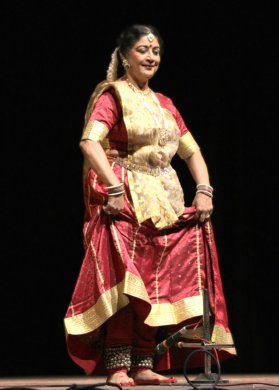 Dr. Malavika Mitra 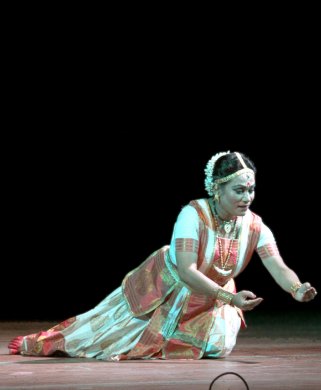 Anita Sharma Sattriya dance - the final, and the most recently recognized classical style - was presented by Anita Sharma. A senior disciple of Guru Jatin Goswami and late guru Raseswar Saikia Borbayan, she has been running her own institution for several years. She began with her two disciples, with Krishna Vandana, describing Krishna's lotus-petalled eyes and lotus-hued feet, attired in a gilded robe and wearing ornaments with full moon radiance. In the Assamese tradition of single-minded devotion to Krishna, however, one has to realise that there is no Radha. Then came the most distinctive number of the Sattriya repertoire, Chali Naach, with its three major segments characterised by grace and cadence. First, Ramdhani was a pure dance sequence. Secondly, Geetar Nach elaborated the text with abhinaya and explored multiple emotions. Finally, Mela Nach demonstrated mnemonics and traditional rhythmic patterns. In the choreography to the song: Utho mere laal..., three different Borgeet compositions by the saint-poet Madhavadeva were blended with an innovative narration on Yashoda's predicaments. She first tries to wake up her beloved child with gentle persuasion. Not succeeding, she talks about the charm of Mother Nature and the morning chores going on in Brajadham. Even failing that, she launches on a description of Krishna's pals, Dama and Sudama playing outside while tending their cows, and - lo and behold! - Krishna jumps out of the bed, rushing to meet them. What a sweet stratagem! In the final Uma Rudra Samvad, as penned by Sriman Sankaradeva, there is another recapitulation of the myths: of Daksha organizing his Yajna sans Shiva; his daughter Uma arriving uninvited and - unable to bear insults heaped on her husband - - giving up her life in the sacrificial pyre in indignation; Shiva storming into the scene to pick up Sati's dead body and launching a world-destroying Tandava; and Vishnu stepping in to save the creation. One wished for a little more verve in visualising the cataclysm and the catharsis. All in all, the six dancers brought in a breath of fresh air in Kolkata's rarefied classical dance atmosphere!  Dr. Utpal K Banerjee is a scholar-commentator on performing arts over last four decades. He has authored 23 books on Indian art and culture, and 10 on Tagore studies. He served IGNCA as National Project Director, was a Tagore Research Scholar and is recipient of Padma Shri. Post your comments Please provide your name and email id when you use the Anonymous profile in the blog to post a comment. All appropriate comments posted with name & email id in the blog will also be featured in the site. |